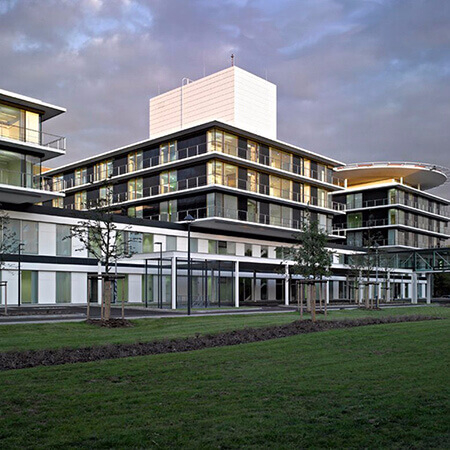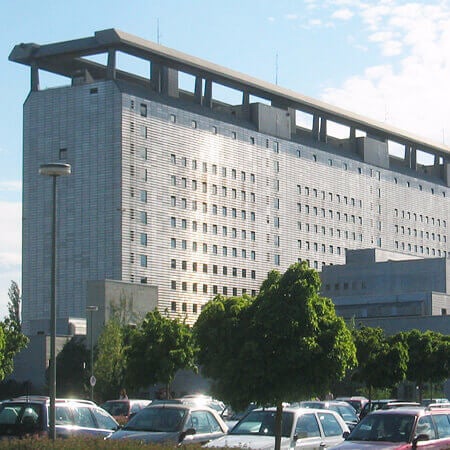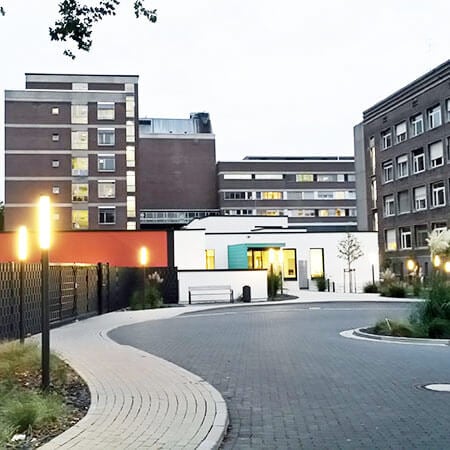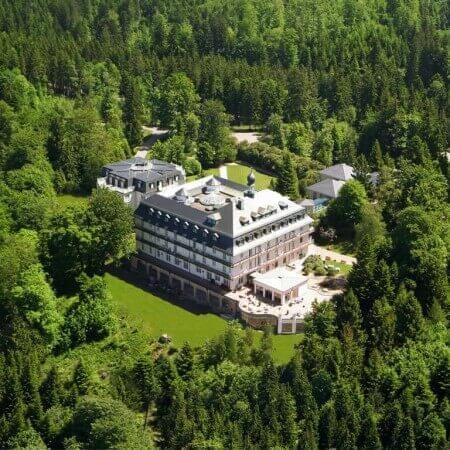Diverticulitis
Due to the difficulties associated with the organization of treatment in Turkey, Switzerland, South Korea and India, we are not currently processing requests to these regions.
If you are interested in treatment in Germany, please leave a request and our specialists will contact you as soon as possible.
Diverticulitis is an inflammation of the diverticulum or the wall of the colon . Diverticulum is a saccular protrusion, which can arise in different parts of the human body, but most often it occurs in the intestine. Western countries have the highest incidence of this illness, which ranges about 35% of the adult population. Diverticulum causes inflammation in 5-10% of patients. The disease more often occurs among the elderly people.
The Booking Health portal presents 82 German clinics specializing in diverticulitis treatment
Show all clinics
Diverticulitis – Causes
Diverticula form in the intestine as a consequence of the following combination of factors:
- Weak connective tissues and muscular structures of the intestinal wall (develops in older people or is congenital)
- Increased pressure inside the intestine (spasms of colon smooth muscles against the background of constipation contribute to that)
Diverticulitis is a result of genetic predisposition in 40% of cases and is a consequence of the patient’s lifestyle in 60% of the cases. There are also risk factors, which can be controlled:
- Poor in fibre diet
- Obesity
- Smoking
The risk of the illness increases under the influence of other intestinal inflammatory diseases or in the case of helminthiasis.
Diverticulitis – Diagnostics
All clinical signs of diverticulitis are nonspecific. Therefore, the establishment of a correct diagnosis without additional examination is impossible.
The diagnostic process is done with the help of the next techniques:
- Ultrasound examination.
- Computed tomography, which is the most accurate non-invasive method of diagnosis. Computed tomography allows diagnose verification in 98% of cases.
- Laparoscopy is performed only in clinical indications presence. This is an invasive diagnostic method when the camera is inserted into the abdominal cavity through a small incision
Some patients undergo other methods of diagnostics, but they are contraindicated in the acute phase of inflammation because of the increased risk of intestinal perforation.
Such diagnostic procedures include:
- Colonoscopy, which is the examination of the intestine internal surface with the help of an optical system, that is introduced through the rectum
- Irrigoscopy is an X-ray with the introduction of contrast medium through the rectum
Instrumental research methods can detect inflamed diverticulum, determine its location and size, and plan the tactics of surgical treatment, if needed.
Best clinics for the diverticulitis diagnostics in Germany:
Diverticulitis – Treatment
There are various degrees of diverticulitis severity. The mild form of the disease is treated on an outpatient basis. Aggravation of the inflammatory process requires admission to the hospital for therapeutic measures. Surgical treatment is also required in some cases.
Conservative therapy is based on a prescription of antibiotics. They destroy the pathogenic bacterial flora, which has caused the inflammatory process. But after effective etiotropic treatment a diverticulum itself doesn’t disappear, so the development of diverticulitis may recur in the future. Doctors prescribe laxatives, antispasmodics, anti-inflammatory drugs for pathogenetic and symptomatic treatment.
Diet therapy. A patient is prescribed a special diet. The most strict diet means complete exclusion of food for several days. Fluid consumption increases up to 2-3 litres per day.
Surgical treatment is performed in less than 30% of patients. Surgery can be an emergency or a planned one. Emergency intervention is performed immediately in the case of diverticulitis complications, which include:
- Acute intestinal obstruction
- Formation of fistulas or abscesses
- Intestinal perforation
- Peritonitis (inflammation of the peritoneum)
- Massive bleeding
Indications for the planned surgical treatment of diverticulitis:
- Frequent exacerbations of the inflammatory process
- Chronic intestinal obstruction
- Presence of an infiltrate in the diverticulum
- High risk of bowel cancer
- Ineffectiveness of drug therapy with long-lasting symptoms
- Constant blood loss, which leads to the development of anemia
Surgical treatment implies the removal of the problematic part of the intestine. Surgery can be performed in an open manner or using laparoscopic measures. Modern German hospitals give preference to the less invasive laparoscopic operations. A doctor inserts a camera and the instruments into the abdominal cavity through the small incisions. Every move is monitored with the help of an image, which is projected on the screen.
Best clinics for the diverticulitis treatment in Germany:


Diverticulitis – Rehabilitation
Rehabilitation is the process of body restoration from injuries, surgeries or diseases. It can have a different orientation such as: oncological, orthopedic, neurological, etc. There is also general therapeutic rehabilitation. It is indicated for patients after conservative and surgical treatment of the internal organs diseases.
The directions of the general therapeutic rehabilitation
There are several main directions of the therapeutic rehabilitation such as:
- Medical one, which includes the restoration of patient's health, normalization of body functions, stimulation of compensatory possibilities, elimination of the chronic pain, etc.
- Physical one, which is responsible for improving of work capacity and tolerance for physical activities. In the complex cases, the purpose of this therapeutic rehabilitation area may be the restoration of the self-service ability.
- Psychological one, which helps to eliminate the mental disorders which may occur as a result of a disease (phobias, depression, apathy), to increase the human motivation, and to adapt to the changed living conditions.
The World Health Organization underlines 3 phases of rehabilitation such as: hospital phase, a phase of recovery and supporting phase. Different tasks are solved in different phases. The hospital phase is conducted immediately after the treatment. After the first phase begins the second one which usually takes place in sanatoriums or rehabilitation centers. This is the boundary between two periods, namely illness and future life. Then a supporting phase is required. The patient maintains the achieved level of his health and physical activity at home or visits the rehabilitation center from time to time.
Therapeutic rehabilitation methods
The most modern rehabilitation programs are used in Germany. They are adapted individually for each patient, and are based on the recent disease, age, physical possibilities, and the results of treatment. Different specialists such as: therapists, psychologists, rehabilitators, kinesiotherapists, physiotherapists are involved in the rehabilitation process.
The following methods of rehabilitation are used:
- Dosed physical activity
- Training on the simulators and in the pool
- Physiotherapy
- Acupuncture
- Manual therapy
- Microcurrent therapy
- Compression therapy
- Lymphatic drainage
- Natural factors of the nature (mud, thermal waters, etc.)
Any rehabilitation may include medicamentous support. It is necessary to hold a consultation with the patient about the proper nutrition and the way of life which is important for him in the current situation.
Rehabilitation programs in Germany are designed for 2 weeks. If necessary, they can last much longer. In this country, the patient is provided with qualitative care, accommodation in comfortable rooms and individually selected meals.
Rehabilitation programs in Germany show one of the best results in the world. Most patients successfully restore their employability and excellent health there. They remain physically active, return to the full social and family life.
Best clinics for general therapeutic rehabilitation in Germany:
Author:
The article was edited by medical expert, board certified Dr. Nadezhda Ivanisova. For the treatment of the conditions referred to in the article you must consult a doctor; the information in the article is not intended for self-medication!
Sources:
Centers for Disease Control and Prevention
The cost of services includes
Here you can find the cost of treatment for this disease at the German University Hospitals. Leave a request and we will provide a free consultation with a doctor and will start organizing the whole treatment process.
The program includes the following:
- Issuing of an invitation for getting a visa for treatment as quick as possible
- Fixing an appointment at a time convenient for you
- Preliminary organization of a comprehensive examination and discussion of the forthcoming treatment plan
- Arranging transfer from the airport to the hospital and back to the airport
- Provision of interpreting services and services of a personal medical coordinator
- If necessary, assistance in the organization of further surgical treatment
- Provision of a medical insurance against treatment complications covering up to 200,000 euro
- Preparation and translation of medical records and recommendations from the hospital
- Assistance in the subsequent communication with your attending physician, including consultations on repeated X-ray images through the unique medical document management system E-doc




